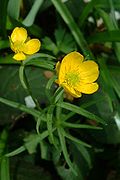Ranunculaceae
Ranunculaceae or the buttercup family is a family of over 2,000 known species of flowering plants in 43 genera, distributed worldwide.
The largest genera are Ranunculus (600 species), Delphinium (365), Thalictrum (330), Clematis (325), and Aconitum (300).
Description[edit]
Ranunculaceae are mostly herbaceous annuals or perennials, but some woody climbers (such as Clematis) or shrubs. Most members of the family have bisexual flowers which can be showy or inconspicuous. The family is noted for its many garden ornamentals and poisonous species.
Taxonomy[edit]
The family Ranunculaceae sensu stricto is one of seven families in the order Ranunculales within the eudicots according to the Angiosperm Phylogeny Group classification.
Distribution and habitat[edit]
The family is cosmopolitan, occurring in temperate and subtropical climates (rarely in the tropics). Most species are found in the Northern Hemisphere.
Uses[edit]
Many genera are well known for their ornamental flowers, cultivated in gardens for their showy, often fragrant flowers.
See also[edit]
References[edit]
<references />
External links[edit]
- Ranunculaceae in L. Watson and M.J. Dallwitz (1992 onwards). The families of flowering plants: descriptions, illustrations, identification, information retrieval. Version: 3 May 2006. http://delta-intkey.com
| Ranunculales | ||||||
|---|---|---|---|---|---|---|
This Ranunculales related article is a stub.
|
|
|
|
Ranunculaceae[edit]
-
Ranunculus auricomis
-
Adonis autumnalis flower diagram
-
Pulsatilla alpina fruit
-
Ranunculus acris
-
Helleborus niger (fruits)
-
Nigella arvensis fruit
-
Glaucidium palmatum flower
-
Hydrastis flower
-
Coptis quinquefolia
-
Creeping buttercup close
-
Thalictrum aquilegifolium
-
Adonis annua flower
Ad. Transform your life with W8MD's Budget GLP-1 injections from $75


W8MD offers a medical weight loss program to lose weight in Philadelphia. Our physician-supervised medical weight loss provides:
- Weight loss injections in NYC (generic and brand names):
- Zepbound / Mounjaro, Wegovy / Ozempic, Saxenda
- Most insurances accepted or discounted self-pay rates. We will obtain insurance prior authorizations if needed.
- Generic GLP1 weight loss injections from $75 for the starting dose.
- Also offer prescription weight loss medications including Phentermine, Qsymia, Diethylpropion, Contrave etc.
NYC weight loss doctor appointmentsNYC weight loss doctor appointments
Start your NYC weight loss journey today at our NYC medical weight loss and Philadelphia medical weight loss clinics.
- Call 718-946-5500 to lose weight in NYC or for medical weight loss in Philadelphia 215-676-2334.
- Tags:NYC medical weight loss, Philadelphia lose weight Zepbound NYC, Budget GLP1 weight loss injections, Wegovy Philadelphia, Wegovy NYC, Philadelphia medical weight loss, Brookly weight loss and Wegovy NYC
|
WikiMD's Wellness Encyclopedia |
| Let Food Be Thy Medicine Medicine Thy Food - Hippocrates |
Medical Disclaimer: WikiMD is not a substitute for professional medical advice. The information on WikiMD is provided as an information resource only, may be incorrect, outdated or misleading, and is not to be used or relied on for any diagnostic or treatment purposes. Please consult your health care provider before making any healthcare decisions or for guidance about a specific medical condition. WikiMD expressly disclaims responsibility, and shall have no liability, for any damages, loss, injury, or liability whatsoever suffered as a result of your reliance on the information contained in this site. By visiting this site you agree to the foregoing terms and conditions, which may from time to time be changed or supplemented by WikiMD. If you do not agree to the foregoing terms and conditions, you should not enter or use this site. See full disclaimer.
Credits:Most images are courtesy of Wikimedia commons, and templates, categories Wikipedia, licensed under CC BY SA or similar.
Translate this page: - East Asian
中文,
日本,
한국어,
South Asian
हिन्दी,
தமிழ்,
తెలుగు,
Urdu,
ಕನ್ನಡ,
Southeast Asian
Indonesian,
Vietnamese,
Thai,
မြန်မာဘာသာ,
বাংলা
European
español,
Deutsch,
français,
Greek,
português do Brasil,
polski,
română,
русский,
Nederlands,
norsk,
svenska,
suomi,
Italian
Middle Eastern & African
عربى,
Turkish,
Persian,
Hebrew,
Afrikaans,
isiZulu,
Kiswahili,
Other
Bulgarian,
Hungarian,
Czech,
Swedish,
മലയാളം,
मराठी,
ਪੰਜਾਬੀ,
ગુજરાતી,
Portuguese,
Ukrainian














